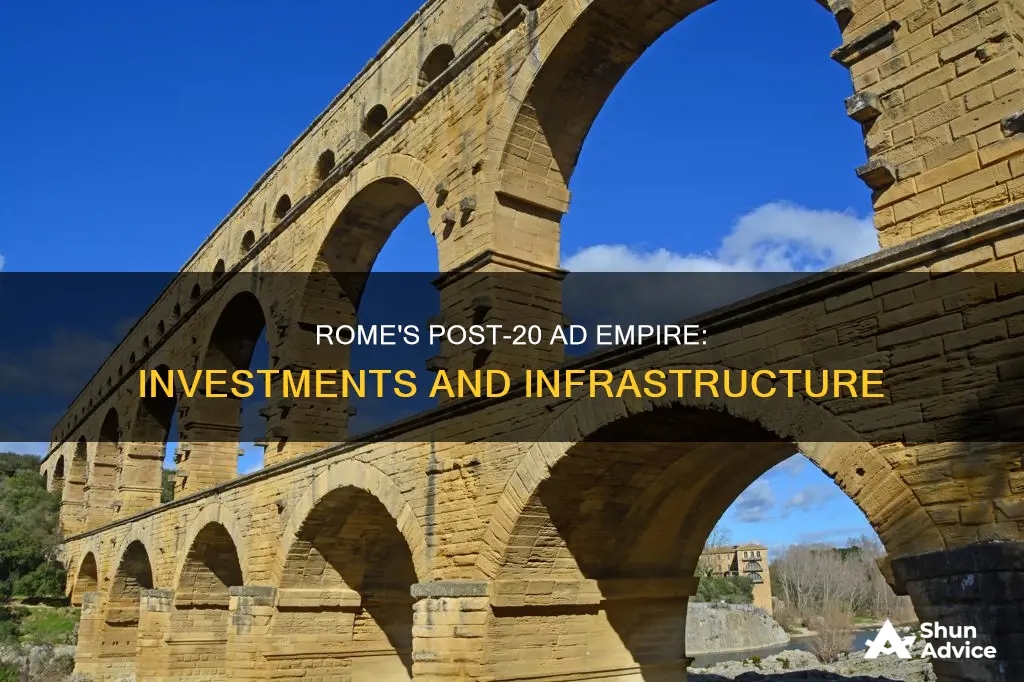
The Roman Empire was founded in 31 BC and lasted until 476 AD in the West and 1453 in the East. After the fall of the Republic and the rise of Julius Caesar, Rome's first emperor, Augustus, began a golden age of peace and prosperity known as the Pax Romana. This period saw Rome reach its greatest territorial extent, with the empire encompassing most of continental Europe, Britain, Western Asia, Northern Africa, and the Mediterranean islands.
Rome's vast empire was maintained through a series of investments in infrastructure, military, and trade. The Romans built over 50,000 miles of roads, aqueducts, and amphitheatres, many of which are still in use today. They also established a standardised currency system, which facilitated extensive trade networks. Wine from Italy, olive oil from Spain, and oysters from the North Sea were among the goods traded throughout the empire.
To defend their territories, the Romans invested in a professional military, with soldiers volunteering for 20 years of active duty and five as reserves. Legionaries were paid by the Imperial treasury and swore an annual oath of loyalty to the emperor. The Praetorian Guard, a unit of nine cohorts, was established by Augustus and based in Italy, where they served as a police force and firefighters in addition to their primary role of protecting the emperor.
The Roman Empire's investments in infrastructure, military, and trade allowed it to maintain its vast territories and facilitated a period of unprecedented stability and prosperity.
What You'll Learn
- The Roman Empire's economy was largely based on trade and agriculture
- Emperors issued coins with their portraits to spread propaganda and symbolise power
- Emperors also funded projects like public works and wars, which led to bouts of inflation
- The Roman army was paid for by the Imperial treasury, and soldiers were well-compensated
- The Roman Empire's territorial expansion was fuelled by its sophisticated military and professional soldiers

The Roman Empire's economy was largely based on trade and agriculture
The Roman Empire encircled the Mediterranean, which they called "our sea" (mare nostrum). Roman sailing vessels navigated the Mediterranean as well as major rivers of the Empire, including the Nile, Tiber, and Rhine. Transport by water was preferred where possible, as moving commodities by land was more difficult and much more expensive.
Roman provinces traded among themselves, but trade also extended outside the frontiers to regions as far away as China and India. The main commodity was grain, but other goods traded included olive oil, garum (fish sauce), slaves, ore, fibres and textiles, timber, pottery, glassware, marble, papyrus, spices, ivory, pearls, and gemstones.
Although most provinces were capable of producing wine, regional varietals were desirable, and wine was a central item of trade. The major suppliers for the city of Rome were the west coast of Italy, southern Gaul, the Tarraconensis region of Spain, and Crete.
The Roman economy was also based on mining and metallurgy. The main mining regions of the Empire were Spain, Gaul, Britain, the Danubian provinces, Macedonia and Thrace, and Asia Minor. Intensive large-scale mining of alluvial deposits took place from the reign of Augustus up to the early 3rd century AD, when the instability of the Empire disrupted production.
The Roman Empire was not uniformly developed. The GDP per capita of Italy is estimated to be higher than the average of the Empire during the Principate, due to a higher degree of urbanisation and trade.
Understanding Your Investment Portfolio Reports: Why They Matter
You may want to see also

Emperors issued coins with their portraits to spread propaganda and symbolise power
The Roman Empire was monetised to a near-universal extent, with money used as a way to express prices and debts. The sestertius was the basic unit of value, though the silver denarius, worth four sesterces, was also used. Emperors of the Antonine and the Severan dynasties debased the currency, particularly the denarius, under the pressures of meeting military payrolls.
The use of coins as a means of propaganda began with Julius Caesar, who became the first living Roman to issue coins with his portrait. This was considered an innovative approach to coin design and was among the most direct forms of propaganda. Caesar's image on the coin promoted him and influenced public opinion to favour his beliefs, actions, and decisions.
Following Caesar, Augustus, Rome's first emperor, was continuously depicted as youthful and vigorous, signifying stable leadership even as he aged. A coin of Augustus can be viewed at Winchester City Museum. The obverse of this coin shows Augustus with a slim face, while the reverse depicts the Battle of Actium, where Augustus defeated Antony and Cleopatra, sending a clear message to adversaries that Rome was an unstoppable military force.
Another example of an emperor using coins for propaganda is Trajan, who ruled from 98-117 CE. The obverse of his coins intentionally mimics Augustus' to send a message to the public of a connection between the two emperors. This form of propaganda was meant to cement Trajan as another representation of the golden age of the Roman Empire.
Coins were also used to spread messages about an emperor's desired image through symbols of Roman victories and messages of divine strength. For example, the obverse of a coin of Vespasian, who reigned from 69-79 CE, shows his portrait in hyper-realistic style, with deep-indented lines around his eyes, symbolising wisdom. The reverse of the coin shows a muscular athletic figure holding a scepter, an idealised Roman body type that was meant to send a message of strength.
In summary, emperors used coins with their portraits to spread propaganda, create public goodwill, and symbolise their power and wealth. This was a highly effective way to influence public opinion and embed certain ideas into society, as coins served a secondary political purpose when used as payment.
Investing Wisely: Earning 50K Annually with Smart Strategies
You may want to see also

Emperors also funded projects like public works and wars, which led to bouts of inflation
The Roman economy was largely agrarian during the early centuries of the Roman Republic, centred on the trading of commodities such as grain and wine. However, following the Punic Wars, the economy became more monetised and a more sophisticated financial system emerged. Emperors issued coinage with their portraits to disseminate propaganda, create public goodwill, and symbolise their wealth and power.
The Roman Imperial monetary economy often suffered bouts of inflation due to emperors funding high-profile projects like public building works and costly wars that offered little material gain. Emperors of the Antonine and Severan dynasties debased the currency, particularly the denarius, to meet military payrolls. This led to a sharp contraction in the supply of specie in the mid-200s and, by the year 300, the money supply and banking sector were greatly diminished.
The Roman army grew significantly during the Crisis of the Third Century, increasing from 250,000 troops during the reign of Augustus to around 600,000 under Diocletian. This put immense pressure on the economy, as the larger army demanded higher salaries and bonuses. Roman mints had to produce more silver coins to pay the soldiers, which resulted in an increase in the number of coins in circulation and a decrease in their individual value.
The vast increase in coin production and its inflationary effects may be compared to "quantitative easing" in modern economies. The value of the coins was further diminished by debasement—a decrease in the amount of precious metal in the coins. This led to a loss of faith in the capacity of the coins to retain value, and people, especially soldiers, demanded more coins. Emperors who failed to meet these demands were often swiftly replaced.
In addition to funding military endeavours, emperors also spent money on public building works. Emperor Constantine, for example, reformed the currency in the fourth century and introduced a new gold unit, the solidus. This unit had a higher status and was used chiefly by soldiers and wealthy people, and its higher precious metal content helped reduce inflationary pressures.
Retirement Planning: Understanding 401(k) Investment and Savings Plans
You may want to see also

The Roman army was paid for by the Imperial treasury, and soldiers were well-compensated
The Roman army was funded by the Imperial treasury and soldiers were paid a stipendium, which constituted the main part of a soldier's income. During the time of Augustus, soldiers were paid 900 sestertii (225 denarii) per year, which was a good wage for the time. Soldiers were also given salt, which is the origin of the word "salary". In addition to their stipendium, soldiers also received the spoils of war, known as donativa.
The stipendium was introduced during the Punic Wars, when pay was set at 2 obols per day, or one-third of a drachma (one denarius after 211 BC). Centurions received twice the pay of their men, or four obols or two-thirds of a drachma per day. In addition to their pay, soldiers were entitled to a share of the spoils of war, which included prisoners sold as slaves, animals, treasure, weapons, and other goods.
Over time, the donativa grew in importance, and by the 4th century, the ancient stipendium constituted only 10-15% of a Roman legionary's entire income. The first increase in a soldier's pay in imperial times came during the reign of Domitian, who increased the stipendium by a quarter, bringing annual compensation to 333 denarii for an Ala knight, 266 denarii for a knight of cohors equitata, and 200 denarii for a foot soldier of cohors equitata.
The cost of maintaining the army put a strain on the Imperial treasury, particularly as the Empire expanded and the number of soldiers increased. Emperors of the Antonine and the Severan dynasties debased the currency, particularly the denarius, to meet military payrolls. Military expenditures constituted about 75% of the total state budget.
Claiming Investment Management Fees: Strategies for Tax Efficiency
You may want to see also

The Roman Empire's territorial expansion was fuelled by its sophisticated military and professional soldiers
The Roman army was a key element in the rise of Rome over "above seven hundred years" from a small settlement in Latium to the capital of an empire governing a wide region around the shores of the Mediterranean. The Roman historian Livy asserts that:
> ...if any people ought to be allowed to consecrate their origins and refer them to a divine source, so great is the military glory of the Roman People that when they profess that their Father and the Father of their Founder was none other than Mars, the nations of the earth may well submit to this also with as good a grace as they submit to Rome's dominion.
Rome's military consisted of an annual citizen levy performing military service as part of their duty to the state. As the extent of the territories falling under Roman suzerainty expanded, and the size of the city's forces increased, the soldiery of ancient Rome became increasingly professional and salaried. As a consequence, military service at the lower (non-staff) levels became progressively longer-term. Roman military units of the period were largely homogeneous and highly regulated. The army consisted of units of citizen infantry known as legions, as well as non-legionary allied troops known as auxiliary. The latter were most commonly called upon to provide light infantry or cavalry support.
The Roman army was far from being solely a defensive force. For much of its history, it was a tool of aggressive expansion. The Roman army had derived from a militia of main farmers, and the gain of new farmlands for the growing population or later retiring soldiers was often one of the campaign's chief objectives. The Roman army underwent a significant transformation as a result of the chaotic 3rd century. Unlike the Principate army, the army of the 4th century was heavily dependent on conscription, and its soldiers were more poorly remunerated than in the 2nd century.
The Roman Empire's territorial expansion was also facilitated by its ability to exploit internal political divisions in the territories it sought to conquer. The Romans often exploited internal political divisions and incentivised compliance through legal privileges and relative independence. Roman government was thus limited but efficient in its use of available resources.
Smart Investing: Turning 10 Lakh into 100 Crore
You may want to see also







